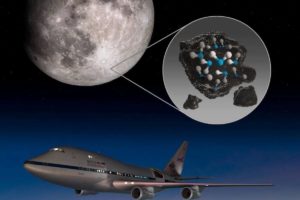Past studies have found that the water on the moon is only at the poles of the moon. The United States Space Agency (NASA) recently released the news of its stratospheric infrared astronomical observatory SOFIA, confirming for the first time the presence of water molecules on the surface of the moon illuminated by sunlight.

The astronomy community has discovered the existence of water long ago, but it has always been believed that water molecules only exist in the depths of craters at the poles. Because they are in the shadow of the crater, the water brought by other stars will not escape due to sunlight. However, NASA recently released the discovery of its SOFIA Observatory, confirming the detection of water molecules (H20) in a crater named “Clavius Crater” in the Southern Hemisphere.
According to NASA, it is estimated that the amount of water detected per cubic meter of soil is between 100 and 412 ppm, roughly 350ml of water per cubic meter of soil, said Jacob Bleacher, Chief Exploration Scientist of NASA Human Exploration and Operations Mission “If we can use the resources on the moon, then we can carry less water and more equipment to help make new scientific discoveries.”
Although the water content detected by SOFIA on the moon is 100 times less than that in the Sahara Desert, it also raises a series of questions, such as how the water on the moon is produced, and how it is in the harsh, airless, and highest Exist in an environment with a sun exposure surface with a temperature of 260 degrees Fahrenheit (127 degrees Celsius).
Scientists speculate that one possibility is that micrometeorites carrying a small amount of water fall on the surface of the moon like raindrops, depositing water on the surface of the moon during impact. Some SOFIA project scientists said they plan to make more observations. According to NASA, SOFIA will look for water in other sunlit locations and moon phases to learn more about the process of water manufacturing, storage and transportation. These data will be added to future lunar missions, such as NASA’s Volatiles Investigating Polar Exploration Rover (NASA’s Volatiles Investigating Polar Exploration Rover) to create the first lunar water resources map for future human space exploration.
Source: NASA











